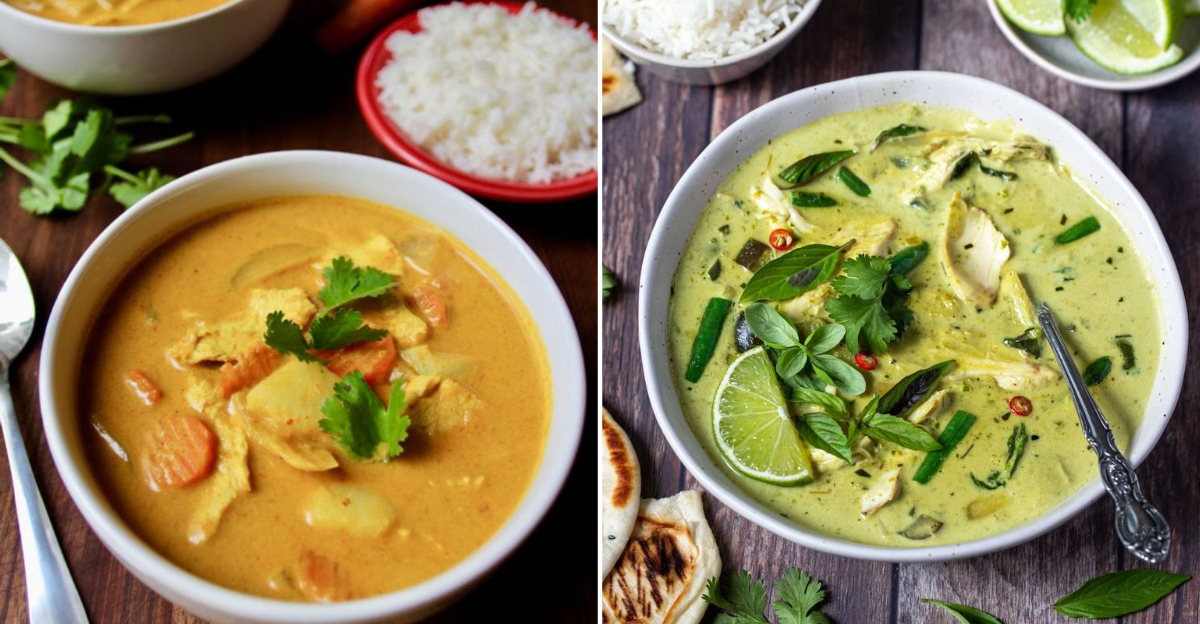20 Delicious Curry Recipes, No Matter Your Spice Tolerance

Curry is the ultimate global comfort food. It is rich, flavorful, and endlessly diverse. Across cultures, it shows up in everything from creamy Thai coconut curries to bold, fiery Indian vindaloos. No matter your spice preference, there’s a version that hits just right.
These 20 delicious curry recipes span the full flavor spectrum, making it easy to find the perfect dish to simmer on your stovetop tonight.
1. Butter Chicken: The Gateway Curry
Butter chicken was my first curry love affair. The velvety tomato sauce, enriched with cream and aromatic spices, offers a gentle introduction to Indian cuisine without overwhelming heat.
The tender chicken pieces practically melt in your mouth. Most recipes call for marinating in yogurt first, which tenderizes the meat beautifully while adding tangy depth.
Perfect for curry newcomers or anyone who appreciates luxurious flavor without fire-alarm spice levels.
2. Japanese Curry: Sweet, Mild Comfort
Japanese curry stands apart with its unique sweet-savory profile and thick, gravy-like consistency. Unlike its spicier Asian cousins, this curry emphasizes comfort over heat.
Loaded with carrots, potatoes, and your choice of protein, it’s essentially a curry-flavored stew. Many Japanese families use pre-made curry roux blocks as their secret weapon, making this an incredibly accessible weeknight dinner.
Serve it over short-grain rice with pickled ginger for an authentic experience.
3. Massaman Curry: Thai-Persian Fusion
Massaman curry bridges worlds with its fascinating fusion of Thai and Persian influences. The aromatic paste combines cardamom, cinnamon, and star anise with traditional Thai elements like lemongrass and galangal.
I once served this at a dinner party and even my spice-averse father-in-law asked for seconds. The coconut milk base keeps heat in check while potatoes and peanuts add hearty substance.
CNN once ranked Massaman curry as the world’s most delicious food, and after your first bite, you’ll understand why.
4. Korma: Nutty, Creamy Indulgence
Korma traces back to Mughal royal kitchens, where chefs created this luxurious dish to please emperors. The sauce combines yogurt, cream, and ground nuts into a silky texture that coats each morsel perfectly.
Despite its rich character, korma typically stays on the milder side of the spice spectrum. Cashews or almonds provide both thickening power and subtle sweetness that balances the aromatic spices.
Try adding golden raisins for little bursts of sweetness throughout this elegant curry.
5. Green Thai Curry: Herbaceous Heat
Green Thai curry delivers bright, lively flavors through fresh herbs rather than dried spices. The signature paste combines green chilies, lemongrass, galangal, and fragrant lime leaves into a vibrant base.
Coconut milk tempers the heat while vegetables like Thai eggplant and bamboo shoots add texture. The first time I made this curry from scratch, the aroma transformed my kitchen into a Bangkok street food stall.
For authentic flavor, don’t skip the fish sauce, which adds that crucial umami dimension.
6. Tikka Masala: Britain’s Adopted Treasure
Chicken tikka masala represents the beautiful evolution of culinary traditions. Though created in Britain by Bangladeshi chefs, it’s now embraced worldwide as comfort food royalty.
The magic happens when tandoori-style chicken meets a tomato-based sauce enriched with cream. Unlike some Indian curries, tikka masala balances spices for flavor rather than heat, making it wonderfully approachable.
The vibrant orange-red color comes from paprika and turmeric, which provide earthy depth without burning spice.
7. Katsu Curry: Crispy Meets Saucy
Katsu curry brilliantly pairs Japanese curry sauce with panko-breaded, crispy cutlets. The textural contrast between the crunchy protein and velvety sauce creates an irresistible eating experience.
The mild, slightly sweet curry sauce typically contains grated apple for natural sweetness. Tonkatsu (pork) is traditional, but chicken works beautifully too for a lighter option.
I became obsessed with this dish during college when a tiny Japanese restaurant near campus served the perfect katsu curry that cured every exam-week stress.
8. Panang Curry: Peanutty Thai Classic
Panang curry offers the perfect middle ground in Thai cuisine. Thicker than red curry but less fiery, its distinctive character comes from the addition of ground peanuts and reduced coconut milk.
The curry paste features dried chilies, galangal, and lemongrass, creating a rounded heat that builds gradually. Kaffir lime leaves add their unique citrus perfume that’s unmistakably Thai.
Choose your protein wisely here. Beef works wonderfully, absorbing the rich flavors during a slow simmer until fork-tender.
9. Chana Masala: Chickpea Powerhouse
Chana masala proves that vegetarian curries can be hearty and satisfying. Chickpeas simmer in a tangy tomato sauce spiked with ginger, garlic, and a customizable blend of spices.
The secret to depth lies in the technique. Blooming whole spices in hot oil releases their essential oils before adding onions and tomatoes. I started making this in college when I was broke, and it remains one of my favorite budget-friendly meals.
Don’t skip the amchoor (dried mango powder) if you can find it. It adds a sour brightness that makes this dish sing.
10. Penang Laksa: Malaysian Spicy Noodle Soup
Penang laksa redefines what curry can be with its spicy-sour fish broth and rice noodles. This Malaysian specialty balances chili heat with tamarind’s tartness and the richness of mackerel or sardines.
The complex broth incorporates lemongrass, galangal, and torch ginger flower for an aromatic foundation. I first tried this at a night market in Kuala Lumpur and was blown away by how the garnishes transform each bite.
Top your bowl with fresh mint, pineapple, cucumber, and a spoonful of shrimp paste for the full experience.
11. Saag Gosht: Spinach and Lamb Harmony
Saag gosht marries tender lamb with iron-rich spinach in perfect harmony. The meat becomes fall-apart tender while simmering in a fragrant blend of garam masala, coriander, and cumin.
Unlike palak paneer, this curry maintains some texture in the greens rather than pureeing them completely smooth. The earthy spinach counterbalances the rich lamb perfectly.
For the most balanced flavor, toast and grind your spices just before cooking. Those few extra minutes make a world of difference in developing authentic depth.
12. Yellow Curry: Thai Golden Treasure
Yellow curry offers the gentlest entry point into Thai curry varieties. Its golden hue comes from turmeric, which provides earthy notes without significant heat.
Coconut milk creates a luxurious base for potatoes, onions, and your protein of choice. The curry paste contains fewer chilies than its red or green counterparts, focusing instead on aromatics like coriander and cumin.
My Thai cooking instructor always said yellow curry is perfect for children or spice-cautious diners who still want authentic Thai flavors without the burn.
13. Dhansak: Parsi-Indian Fusion
Dhansak beautifully represents Parsi culinary heritage by combining Persian and Indian techniques. This unique curry melds lentils, vegetables, and meat into a sweet-sour-spicy harmony that’s utterly comforting.
The lentils break down during cooking, naturally thickening the curry while adding protein and fiber. Traditionally served with caramelized brown rice, this meal offers balanced nutrition in one delicious package.
The signature flavor comes from a splash of jaggery (palm sugar) and vinegar added near the end of cooking.
14. Red Thai Curry: Bold, Balanced Heat
Red Thai curry delivers moderate heat balanced by coconut milk’s cooling creaminess. The vibrant paste combines dried red chilies with lemongrass, galangal, and shrimp paste for incredible depth.
Bell peppers, bamboo shoots, and Thai basil add color and texture to this aromatic dish. The first time I ordered this in Thailand, I was surprised by how the coconut sweetness perfectly tempered the chili heat.
For best results, use full-fat coconut milk and finish with a squeeze of lime to brighten all the flavors.
15. Makhani Dal: Buttery Lentil Luxury
Makhani dal transforms humble lentils into a restaurant-worthy delicacy. Black lentils and kidney beans simmer slowly until creamy, then get enriched with butter, cream, and a fragrant tomato sauce.
The secret lies in the unhurried cooking process. Traditional recipes call for overnight simmering, allowing the lentils to break down completely while absorbing all the aromatic spices.
Sometimes called dal bukhara or dal makhani, this dish proves that vegetarian food can be indulgent and satisfying without trying to imitate meat.
16. Vindaloo: Fiery Goan Challenge
Vindaloo stands as the spice champion in Indian cuisine. This Goan specialty traces its roots to Portuguese colonists who introduced vinegar preservation techniques to India.
The name itself comes from “vinho” (wine) and “alhos” (garlic), highlighting two key ingredients. Authentic vindaloo contains no potatoes, despite the confusing “aloo” in its name. That’s just a linguistic coincidence.
I once challenged my spice-loving brother to a vindaloo eating contest. Neither of us could speak properly for twenty minutes afterward.
17. Massoor Dal: Simple Red Lentil Comfort
Massoor dal celebrates simplicity with minimal ingredients and maximum satisfaction. Red lentils cook quickly, breaking down into a creamy consistency that feels like a warm hug in food form.
The tadka (tempering) makes all the difference. Sizzling cumin seeds, garlic, and dried chilies in hot ghee creates an aromatic oil that transforms the basic lentils when poured over top.
This was the first curry I learned to make from my college roommate, and its humble ingredients belie its complex flavor.
18. Jalfrezi: Stir-Fried Spice Sensation
Jalfrezi represents British-Indian innovation at its finest. Originally created to repurpose leftover meat during colonial times, it’s now a restaurant favorite worldwide.
Unlike saucy curries, jalfrezi keeps vegetables crisp-tender through quick cooking. Bell peppers, onions, and tomatoes retain their distinct textures while soaking up the spicy sauce.
When I visited Birmingham’s Balti Triangle, a chef told me proper jalfrezi should always have visible green chilies and a sauce that clings to the ingredients rather than pooling on the plate.
19. Keema: Minced Meat Magic
Keema transforms humble ground meat into a flavor explosion. This versatile curry pairs beautifully with both rice and bread, making it an everyday staple across South Asia.
The fine texture allows spices to permeate every morsel, creating consistent flavor throughout. Traditional versions often include peas for color contrast and subtle sweetness against the savory meat.
Growing up, my neighbor would bring over her family’s keema recipe during Ramadan. The fragrant combination of ginger, garlic, and garam masala would have us counting the minutes until iftar.
20. Chettinad Curry: South Indian Fire
Chettinad curry hails from Tamil Nadu, where spice traditions reach their zenith. The distinctive masala blend might include up to 30 different spices, creating unparalleled depth and complexity.
Black pepper features prominently, providing heat that builds gradually rather than overwhelming immediately. Star anise, fennel seeds, and kalpasi (stone flower) contribute unique aromatic notes rarely found in other curry styles.
Despite its fiery reputation, authentic Chettinad curry balances heat with tanginess from tomatoes and tamarind for a sophisticated flavor profile.
